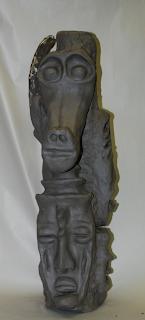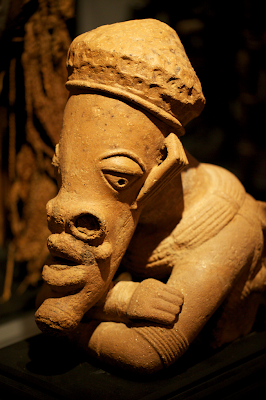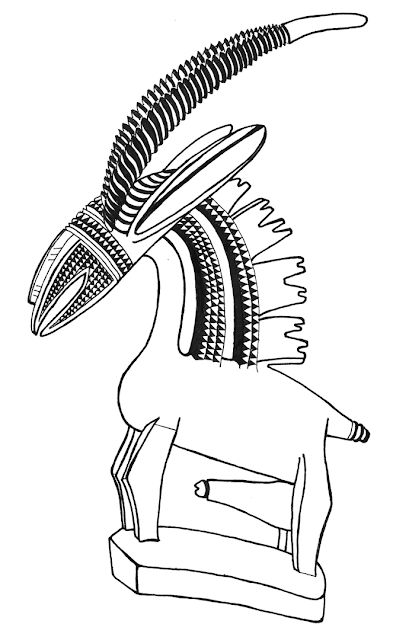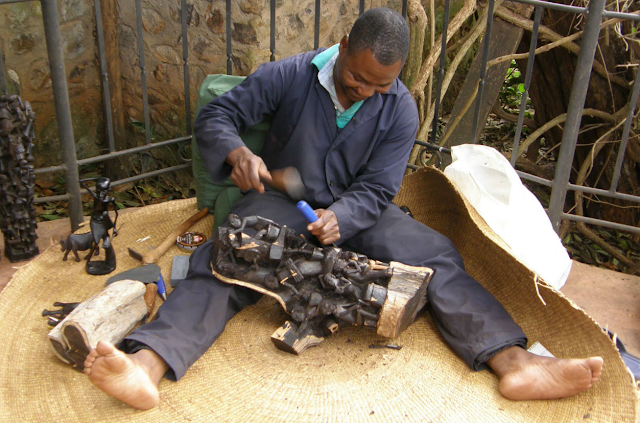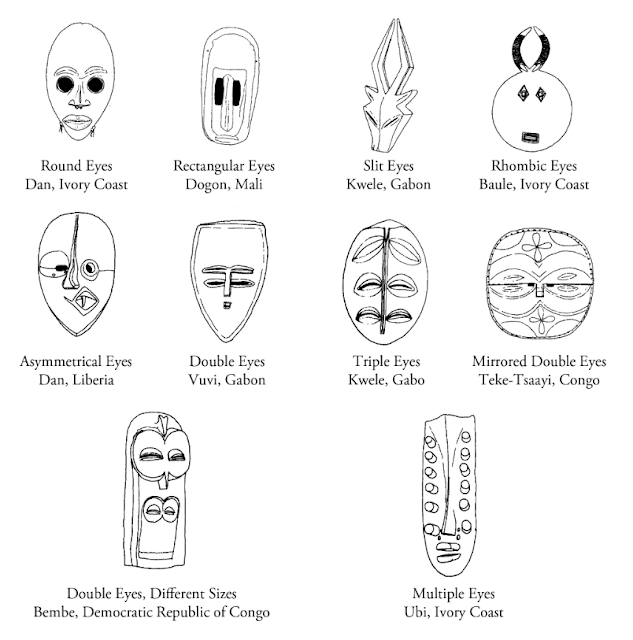Friday 30 November 2012
Empowerment Of The Consumer
In developing my own 'Ojo De Dios' designs, I began looking at it as more than a representation of time and warranty. What if I use my interpretations of tribalism as a tool for empowerment of the consumer, or tribesman. In tribes the signs of power and wealth vary between cattle, daughters, wives and crops - but what is the modern equivalent. Can this 'Ojo De Dios' visual concept be reinterpreted as a visual tapestry of one's position. In the 'Apple Tribe', this could almost be an all-encompassing barcode of all the consumables a member owns - the more the better. Is this something physical that would be displayed freely? Or something digital that is linked to the devices and user account?
Wednesday 21 November 2012
Tribalisation
The Territories Presentations are upon us, here is a graphic outlining my concept so far. Looking at tribal civilisation and how it has been affected by the spread of colonialism, I want to explore the narrative of tribalism spreading in our modern society. This is not to focus on the overt, wherein the tribal system is dragged and dropped forcibly in a society where it doesn't really belong any more (though this is the way colonialism and empires spread, it's slightly too ignorant to design for such circumstances).
The idea is to look at the more subtle nuances of tribal life in our everyday and how they can be emphasised. I also need to stop borrowing visual language from tribes - the designs and tribes of my project need to emerge from the culture within which they are based.
What Is A Tribe?
A tribe is best defined by its members rather than by outsiders - a group of people can be considered to belong to the same tribe if they:
- regard themselves as having the same customs and language
- are descended form the saem group of ancestors
- have a sense of political affiliation that reaches beyond the family unit
- regard themselves as having the same customs and language
- are descended form the saem group of ancestors
- have a sense of political affiliation that reaches beyond the family unit
Sunday 18 November 2012
Interview With A Tribesman
This is Joel Yawanawa, a member of the Amazonian 'Nixiwaka' tribe, and as of last year, my new god-brother. I recently conducted an interview with him and his wife, Oona, who travelled deep into the Amazon rainforest to live with his tribe, fell in love and moved to London. It was a great opportunity to see views of tribal life through the eyes of Joel who grew up there, and Oona who adapted to their customs. It also raised the question - what did Joel bring from the tribe to London, if anything? I am currently editing the footage and will post the interview soon.
Tuesday 13 November 2012
Ojo De Dios
The 'Ojo De Dios', or 'God's Eye' is a ritual tool and cultural symbol with magical and spiritual associations. For the Huichol peoples of western Mexico, the 'God's Eye' is symbolic of the power of seeing and understanding that which is unknown and unknowable, The Mystery. The four points represent the elemental processes earth, fire, air, and water. Physically, the 'God's Eye' is a simple or complex weaving made across two or more sticks. When a child is born, the central eye is woven by the father, then one eye is added for every year of the child's life until the child reaches the age of five.
It's fascinating to see the concept of birth, or creation, being represented through a physical monument or design. Tying it in with the 'tribalisation' or our culture, I would like to perhaps look at representing the creation and sustenance of consumer products, such as those of Apple, through these kinds of designs. For instance, can each Macbook have a 'God's Eye' created randomly to symbolise it's creation and creator, which would then develop over time to show it's age and perhaps relate to any warranties.
Sunday 11 November 2012
Incense Warranty Prototype
I have been sculpting and sketching various ideas in anticipation of this idea for physical warranties. The totem pole in African and Native American tribal belief is a strong protective image, intimidating outsiders and evil spirits. I am not sure at the moment how exactly incense will work as a material, yet it is unlikely that it can be manipulated too easily so moulding may be the only option.
Friday 9 November 2012
Cardboard & Gaffa
In class, we were set the task of recreating an existing object that tied into our projects. Displayed above is my interpretation of an indigenous American spiritual charm, which would feature in tribal villages as an interaction with the spirits that exist in their surroundings. The use of the charm is linked to the spirits which it calls upon - for example asking for protection or a plentiful harvest.
This has evolved in my mind as a potential tribal artefact for today. Looking at the 'Apple Tribe', the most obvious form of protection is the warranty. My idea for the next design step is to recreate a spiritual charm as a physical warranty, offering a tangible form of protection for the user. The issue of time also is involved in warranty, so I intend to make these charms out of incense, a material that can burn for the longevity of the intended protection plan.
Friday 19 October 2012
A Basement Full Of Masks
Now this was an interesting experience. Heading slightly outside of the planned excursions, I ventured into the Barakat Gallery in Mayfair. After speaking to the owner of the gallery, Mr. Fayez Barakat, and hearing a wonderful anecdote about a meeting with Picasso, I was invited into his basement. Rather than run in fear, I decided to take him up on the offer and was greeted with an incredible collection of African artefacts, densely sprawled around the room. Honestly, I think I have found the Holy Grail of mask collections here and my future home - this was only furthered by the claims by Mr. Barakat that he is the owner of the largest collection of African masks in the world. The week is barely half way gone and this will no doubt be the highlight of my travels.
To elaborate on the Picasso anecdote, I was told that a young Mr. Barakat, eminent art collector at the time, encountered the legendary artist one day in his father's gallery. Pablo Picasso had come in with the Mayor of Jerusalem, raving about African art and the trips he had recently been on. Shocked and confused, Mr. Barakat cut him short and claimed, 'how can you talk of this African art when I have such wonders as ancient Egyptian and Greek artefacts for you to see. These are the greatest examples of art in history'. Picasso responded, 'it is true that these are great cultures, but in Africa people are born artists. They are taught to paint, to draw and to sculpt in the developed world; in a tribe, you can only create art as a birth right and you live it every day of your life, you engage with the spirits'. The next day Mr. Barakat was invited to Picasso's show, only then realising the identity of the person that he had been talking to. It was that day he began his collection of African art.
Horniman Museum
Second on my adventures was the Horniman Museum, which I have to say was a really fascinating place. It's tiny, but packs in exhibitions which are at the very least as good, if not better than the Natural History Museum. They have a fascinating collection of African artefacts and tremendously detailed information on the subjects. I think I found out more specific details here than in all 4 of the books I have read so far. This has contributed to my research into the meaning and designs of masks and I shall soon develop an in depth guide which will inform the next stage of this project.
Transport Museum
So this is our travel week, designed to get us out of our dingy, lugubrious houses and into the bright, exciting world. My first stop this week was at the Transport Museum, where there is an exhibition on maps and art at the time of writing. I saw this as research into possible communications of locations of tribes that I am looking at creating. I like the idea of representing a designated tribe's territory through an illustrated map, maybe including warring tribes and other landmarks. The lower image is a very interesting style that I may experiment with in the near future.
Sunday 14 October 2012
Tribe (The Book, Not The Series)
I found a nice quote in this book regarding how you define a tribe; "a tribe is best defined by its members rather than by outsiders - a group of people can be said to belong to the same tribe if they regard themselves as having the same customs and language, if they are descended from the same group of ancestors, or if they have a sense of political affiliation that reaches beyond the family unit."
It's interesting to look at the tension of groups that properly fulfil the criteria of being a tribe, yet refuse to be associated with the term, such as the amish. But what is behind just a term? It's the overall connotation that tribes have. There's a somewhat negative and superior attitude towards tribes, which is even documented as far back as julius caesar, who decided he could steamroll all the other cultures and bring them under his own, more developed society.
As for design opportunities, can i use the previously defined criteria to denote modern tribes and create tribal values, ceremonies and artworks for them? Also give them tribal names and territories, maybe even initiations? For instance people who vote labour, freemasons etc.
The Adi Tribe
More on the Adi tribe that was shown in the BBC documentary. It was fascinating to see how their values fit into daily routines. For example, mithuns, a cow/water buffalo, are a living currency for the tribe, they are not milked or slaughtered for meat. The only justified reason for killing these mithuns are as a sacrifice to the spirits, which feature prominently in their beliefs. If the spirits are not appeased, they apparently spread illness. If a tribesman gets ill they go to a shaman. The shaman looks at a leaf which tells them what is wrong and what spirits to engage in a ritual.
While all this is happening, there is a spread of christianity in the adi tribes, which comes as a result of christian missionaries coming to the area at various points in time and helping illnesses get better with massages and simple medicine. As a result, some of the people now follow the religion as it has proven more successful at 'protecting' them. When it comes to ceremonies, young people have started doing different dances and songs because of the influence of Bollywood movies. The one redeeming thing about all this modernisation, is the fact that there is a village council of everyone, who decide on matters, even crime. Changes from the outside world have come at the request of villagers, not outsiders.
When it comes to a design project and analysing this research, the interesting tension comes in this interaction between the tribe and the outsiders. It is decided by the tribespeople, yet it is the fault of outsiders that any modernisation has happened in the first place. What would our society be like if everyone collectively decided on what was given to us and what wasn't?
Tribe (The Series, Not The Book)
I have begun watching various series and films regarding tribal ceremony and culture. The first of which is Tribe, a BBC documentary in which the clumsy yet affable host, Bruce Parry, lives within a community for a month, gaining a deep understanding of their values and everyday life. This also highlights the tension between these somewhat ancient cultures and the influence modern society is having on them.
The first tribe visited were the Adi in the Himalayas. IT was interesting to see this community, which was half way between their traditional beliefs and adapting to the modern world they have been exposed to. Amazingly, the Indian government has actually closed this area off from outsiders, perhaps as a cautionary measure to make sure these people and their culture isn't completely corrupted.
Western Society Without Ritual
'The redemption of Western society depends on the rediscovery of meaningful ritual. Ritual is at the heart of true communities. It can be an antidote to money-power and corruption. Above all, it honours the integrity to the individual's right to self-expression and self-fulfilment.'
Malidoma Some
Monday 8 October 2012
Koré Dugaw
Koré represents the highest level of initiation society. Its members achieve a degree of spiritual knowledge that enables them to experience a mystic union with divine power and enter a perpetual cycle of reincarnation. In order to reach the highest plateau, these people have to submit themselves to painful initiation rites which include their symbolic death and resurrection. The antics of the wearers of these masks were scandalous and broke every taboo in performance - parodying sexual behaviour, smashing implements and devouring everything in sight, even excrement. This unrestrained behaviour not only proved the physical and mental prowess of the Koré Dugaw, it attested to a state of superhuman transport in which social conventions paled to insignificance.
Chi Wara Antelope
Dogon antelope masks are highly abstract, with a general rectangular shape and many horns (a representation of abundant harvest. Bambara antelope masks (called Chi Wara) have long horns representing the thriving growth of millet, legs (representing roots), long ears (representing the songs sang by the working women at harvest time), and a saw-shaped line that represents the path followed by the Sun between solstices. The performance ensures the fertility of the fields, and is always performed at the beginning and end of a harvest. The larger a Bamana man's harvest, the more in demand as a husband he will be. The Bamana look upon plowing and sowing as a process akin to the sexual act. Sexuality and agricultural activity are closely related in their minds, since both ensure human survival.
Bwa Plank Mask
The eyes set off by concentric circles are intended to recall an owl, whose importance is as a protecting spirit and guide to the underworld. The hooked shape extending from the forehead alludes to the hornbill, which is called upon for hunting. The rows of small triangles represent the hoof prints of koba antelope and also carry the masculine number of three. The black squares of the checkerboard pattern symbolise the old, darkened goat skins sat upon by the elders and their great wisdom. The white squares, in turn, represent the new, light coloured goat skins sat upon by young, inexperienced initiates.
Who's Behind The Mask?
One thing that hasn't become completely clear so far is who wears and performs in the masks. So far, I have found some masks that are for initiates and some that are for witch doctors or shamans. But with such a wide range of masks, who wears the rest? What makes someone worthy to perform this role and coalesce with the spirits? Is it an inherent ability within the actual masquerading ceremony or the mask itself that allows anyone wearing it to channel the intended spirit? Or are these highly enlightened individuals?
The Mask Wearer
In most traditional African cultures, the person who wears a ritual mask conceptually loses his or her human identity and turns into the spirit represented by the mask itself. The mask wearer thus becomes a sort of medium that allows for a dialogue between the community and the spirits (usually those of the dead or nature-related spirits). The transformation of the mask wearer into a spirit usually relies on other practices, such as specific types of music and dance, or ritual costumes that contribute to conceal the mask-wearer's human identity.
Seriously Impressive Masks
I was so impressed with these 15 foot tall plank masks from the Bwa tribe in Burkina Faso that I felt compelled to post them here. I can only imagine what it would be like to carve one of these things out of a whole tree. Maybe something to keep in mind for the future...
The Mask Carver
The role of the mask carver in this whole ceremony is actually an interesting one. Rather than seeking to become accomplished and successful, the only case the sculptor would seek renown is for the prosperity and social respect it entails. Though skilled scupltors often do enjoy considerable social respect, not even the most gifted of them are placed on a pedestal. In fact, their works belong to the king of the tribe and are effectively attributed to him. Since may masks serve ritual purposes and are considered magically powerful objects, it is not surprising that the work of the mask carver is accompanied by religious ritual. He works outside the village, usually at a place considered to be sacred, and he must observe certain rules of ritual cleanliness (fasting, isolation from women, sexual abstinence and avoiding anything associated with death). It is characteristic of the mask carver, however, that he never participates in the ritual wearing of masks in dances or performances.
Eye Typology
A great deal of symbolism and detail comes with the eye forms used in masks. Not only do different tribes follow their own style when representing eyes, they also use varying forms depending on the mask's purpose. For example, Round eyes often allude to feminine beauty, whereas asymmetrical eyes show illness or affliction from evil spirits.
Mask Forms
The first thing worth researching is the various mask types found among tribes. This does not represent the styles but rather the way they are worn. Up until now I have almost solely approached african masks in a bubble, out of their usual context, so I definitely want to explore beyond the façade.
"There is so much more to African masks than just aesthetic pleasure"
Jean Paul Barbier
My First Creative Inspiration
I may not have reached my current position as a designer had I not been truly inspired by african art whilst in college. This really was the point when I started to create freely. Shown here in the images are my first ever clay sculpture, which was of an anthropomorphic Dogon head from Mali. I find the style, shape and animalistic elements fascinating, especially when you understand them in 3D. This was my starting point and from now I wish to gain a much deeper understanding of African masks and tribal ceremonies.
Saturday 6 October 2012
Ethnic Groups of Africa
This map gives a little insight into the massive variety of masquerading traditions spread across the African continent. Only the 101 tribes with the most well recognised mask ceremonies have been published here and each of them are unique.
Subscribe to:
Posts (Atom)





